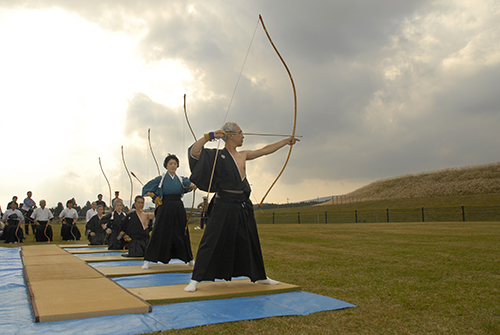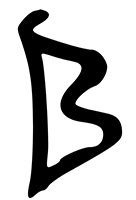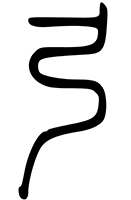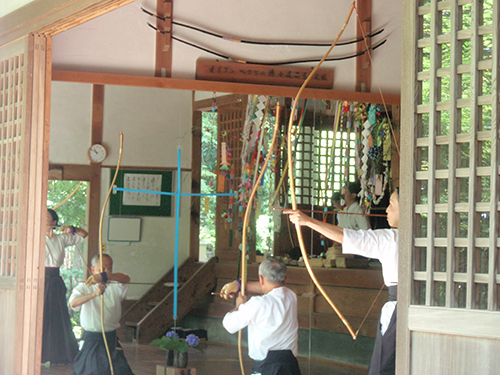57. The "Bow" Radical: 弓
Behold the bow in all its beauty:

Photo Credit: Sgt. Ethan E. Rocke
Here we see a demonstration of 弓道 (きゅうどう: (Japanese) archery), a word that literally means "the way of the bow." For our purposes, the picture more usefully shows the shape of an archery bow, which the autonomous 弓 kanji supposedly depicts:
弓 (836: bow)
According to Henshall's newer edition (the source of all etymological information in this Radical Note), some old forms of the character included a bowstring, but it disappeared from the seal script onward. Two old shapes from Richard Sears's page confirm Henshall's statement:


Right: Seal-script version of 弓, without a bowstring.
The three-stroke 弓 shape matters to us in this Radical Note less because it's an autonomous kanji and more because it doubles as the "bow" radical, one that is on duty in 11 Joyo kanji, including 弓 itself.
What's the Japanese Name of the 弓 Radical?
The 弓 kanji carries the Joyo kun-yomi ゆみ, so it makes sense that ゆみ is also the name of the radical. We can use that name for the centrally positioned 弓 in these kanji:
弟 (177: younger brother; apprentice)
弔 (1588: mourning; condolences; to hold a memorial service)
When the radical slides to the left and becomes narrow, we can instead use the name ゆみへん (弓偏), where 偏 means "left-side radical." Here are examples:
引 (77: to pull; attract; catch (a cold); cite; withdraw; subtract; take over; consult (a written source); apply; emphatic verbal prefix)
強 (100: strong; to force; emphasize)
張 (752: to expand; tension; persist; cover; stick out; watch for; display; style; counter for bows, stringed instruments, and paper lanterns)

Photo Credit: Eve Kushner
At Engaku-ji Temple in Kamakura (in Kanagawa Prefecture, south of Tokyo), this photo shows what bows look like at multiple stages of usage, including the stringless bows on the wall.
By the way, here's an unexpected expression involving our 弓 kanji:
傷弓の鳥 (しょうきゅうのとり: person who is once bitten, twice shy; someone who has become overly cautious due to a bad experience)
The idea is that after a bird has been shot with an arrow, it fears the sound of a pulled bowstring. The traumatized bird becomes extremely cautious. It's interesting that the expression includes 弓, even though the arrow inflicted the harm.
Bowstrings
The word 弓弦 (ゆみづる: bowstring) provides a double dose of our radical. The second kanji is as follows:
弦 (1228: instrument string; bowstring)
Henshall tells us that this character combines "bow" with 玄 (originally a depiction of "twisted threads"). The 玄 might be a phonetic with the associated sense "attach." If so, the whole character means "attach to both ends of bow," which is to say "bowstring." Alternatively, he says, this 玄 could mean "thread." Even if that were the case, 弦 still originally represented "bowstring." This meaning later generalized to "string," including those on musical instruments.
The next character doesn't mean "bowstring" but does have a connection to that concept:
弾 (1570: projectile; to play (stringed instrument); bounce back)
This character combines "bow" with 単, a phonetic contributing the associated sense "round ball." Thus we have "bow to project stone missiles." By extension this meant "hit; pull bowstring; play stringed instrument."
Photo Credit: Eve Kushner
In Kawasaki City (which is in Kanagawa Prefecture on Honshu), a sign includes 弾く (ひく: to pluck strings) in the rightmost text:
お琴を弾いてみませんか?
Don’t you want to try to play the Japanese zither?
琴 (こと: Japanese zither)
For much more on this instrument and on the rest of the sign, see essay 1178 on 琴 (Japanese zither; stringed instrument; Western instrument).
A Bow Plus a Stroke
The following common kanji consists of our radical plus a separate vertical stroke:
引 (77: to pull; attract; catch (a cold); cite; withdraw; subtract; take over; consult (a written source); apply; emphatic verbal prefix)
Henshall cites a scholar who interprets 引 as depicting a "bow" plus a "bowstring." He mentions that other researchers perceive the long vertical stroke as a phonetic contributing the associated sense "pull, extend."
Sending the vertical stroke through the heart of our radical produces quite a different meaning:
弔 (1588: mourning; condolences; to hold a memorial service)
Henshall provides multiple points of view about this shape. One scholar takes it to be a pictograph of a "snake clinging to a person." Another sees a "vine hanging down from a pole." A third perceives it as 人 ("person") + 虫 or 蛇 ("insect" or "snake," respectively), where the non-人 shape is a phonetic. Yet another view is that 弔 symbolizes a "string attached to an arrow."
The Rorschach test continues when we add two small strokes to the top:
弟 (177: younger brother; apprentice)
Per Henshall, old forms of this character depict a "weapon handle wrapped with leather." The handle can be thought of as the lower part of a weapon, so "low; order" and "younger brother" became associated meanings, according to two researchers.
Photo Credit: Eve Kushner
The Japanese concept of a ビデ (bidet) is quite narrow, representing only a device to wash female genitals, nothing more. That’s why the icon on that fourth button shows a woman. By contrast, the two buttons to its left are specifically for washing the rear end. The やわらか option does that more gently.
Be that as it may, I'd like to focus not on the genitals but rather on the three instances of our radical, all on the left under 水勢 (すいせい: force of water). I'm referring to these two kanji:
強 (100: strong; to force; emphasize)
弱 (138: weak)
Those buttons determine the power of the stream.
Henshall's etymology for 強 is convoluted, so I'll present only this intriguing part: "It is thought that the bow, being of standard length, may have had the additional role of being a convenient tool for making land measurements." Indeed, Breen defines the word 弓 not only as "bow" but also as “unit of distance to an archery target (approx. 6 feet)” and “unit of distance for land surveying (approx. 8 feet).”
As for 弱, he says the early form (seal script) consists of "two bows each" with a three-stroke embellishment, leading one scholar to interpret the character as depicting "two ceremonial bows." Not intended for use in warfare, they weren't robust, thereby conveying "weak." Another researcher sees the early shape as representing a bow being bent on a frame so it could flex. This meant "weak" by extension.
Expansion and Curves
Let's examine two more etymologies involving the shape of a bow:
張 (752: to expand; tension; persist; cover; stick out; watch for; display; style; counter for bows, stringed instruments, and paper lanterns)
This character combines "bow" with 長 (long), a phonetic with the associated sense "expand." Thus, the whole character represents "bow expands," which generalized to "expand outward" and then to "stretch."
弧 (1230: arc)
This character unites "bow" and 瓜 (squash, gourd, melon), the latter serving as a phonetic with the associated sense "round, rounded." All together, then, we have "curved bow." This probably once referred to a type of bow with a distinctively curved profile, but the sense later generalized, with 弧 coming to mean "arc shape."
Don't Confuse 弓 with 己
A final note: Don't confuse 弓 with the similarly shaped 己. That is radical 49 ("oneself" or "snake") and has the variant shapes 已 and 巳. As a Joyo kanji, 己 likewise means "self." Originally the pictograph of a "twisted end of a length of thread," this shape was simply borrowed to represent "oneself," according to Henshall.
